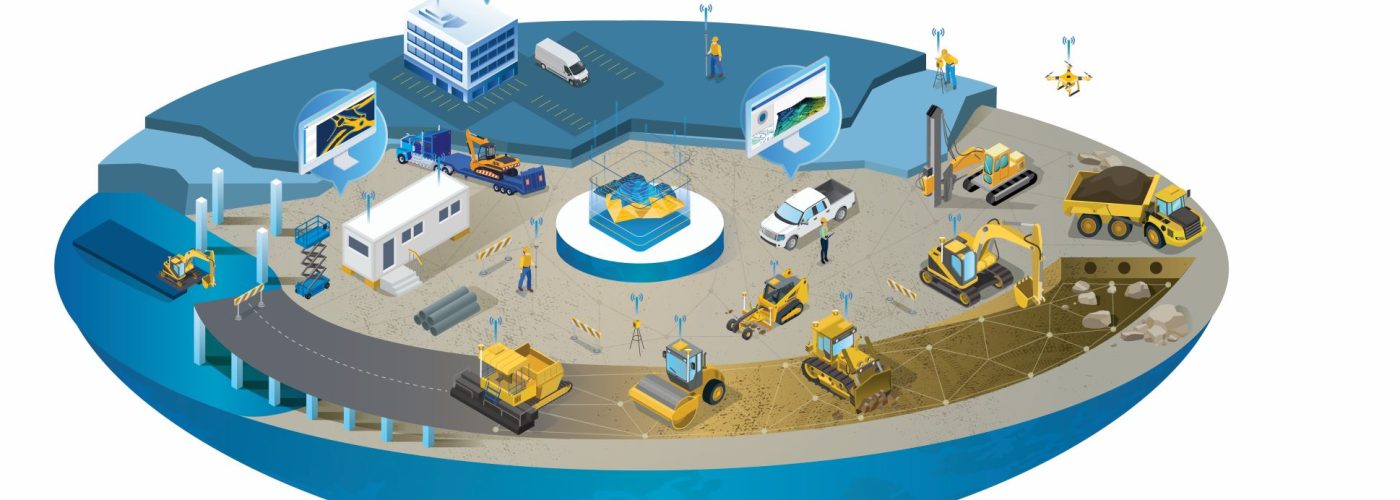Construction is almost back to pre-COVID levels, according to Eurostat, but this doesn’t mean that the construction industry will be back to its pre-COVID ways of working. The industry is rapidly adopting technology to increase productivity, safety, accuracy and traceability. Here Ian Barnes, Head of Business at SITECH UK & Ireland, a leading distributor of Trimble® machine control technology for the civil and heavy construction industry, shares his thoughts on the technologies we can expect to become more important in our the industry in 2021 and beyond.
The construction industry can learn a lot from industries like manufacturing, where cutting-edge facilities are operating in an entirely autonomous way. Construction, historically, was a highly manual industry, but the industry continues to innovate age-old processes for the better. Accelerated by the COVID-19 pandemic and one of the biggest projects across Europe in the past 100 years, 2021 will be the year civil and heavy construction companies embrace a host of new technologies to connect and enhance their on-site operations.
On-site project and progress tracking
The industry has seen a significant uptake in technology, such as site positioning equipment, machine control and telemetry. Technology tracks, updates and maps the progress of operations, such as hydraulic control and cut and fill. Many operators choose machine control because of its benefits, such as reduced double handling, lower fuel consumption and improved accuracy and efficiency. Technology adapts on-site field-to-finish workflows into an office-to-field-to-finish for 360-degree operational awareness.
The A14 improvements are one of the first projects to be delivered on time and to budget, largely helped by the investment in connected technology. The way the project was managed and the technology used resulted in some impressive statistics and gains, such as building 126 new lane miles in 14 million man-hours. Connected site technology allowed improvements in productivity and, on this large scale, caused a dramatic time and cost saving.
Drones
PwC’s membership network report, Skies without Limits, revealed that cost savings from using drone technology is expected to uplift the UK’s construction and manufacturing industries by £8.6 billion by 2030. Construction businesses are turning to drones to help with data analytics and as a visualisation platform for earthmoving applications, to improve surveying accuracy across large areas and to collect and share data.
Operators can use drones to accurately collect and communicate relevant data between the site and the office. Access to real-time drone footage enables site managers to keep up to date with the progress of the project, which means they can organise the correct equipment and materials when required. Integrating data analysis into site management reduces lead times and avoids project delays because materials and equipment are on site exactly when they are needed.
Connected software
Intuitive, workflow software like Trimble® WorksManager can sync real-time data between the field and the office. This connected approach enables Site Managers to oversee a project remotely and make data supported decisions based off real-time data, without time lags.
By integrating a connected approach with design software, such as Trimble® Business Center, changes can be wirelessly and automatically communicated, so that everyone is working to the most up-to-date design. When the design has been finalised in Trimble Business Center it will be sent to the cloud during the export process, ready for the operator to download. Once the operator has selected the new design, they will be able to monitor the correct cut/fill values against design to avoid over dig and work more efficiently. As-built data can be collected and compared against design back in the office as part of the QA process. Visuals of sites before, during or after can also be provided to avoid challenges in advance, or even progress versus design.
Augmented reality (AR)
Final designs can be hard to visualise in the early stages of a project, and it can be time-consuming to check if there are any clashes, such as underground pipes that restrict the amount of possible groundwork. AR-enabled devices, like Trimble® SiteVision, project designs in 3D over the existing landscape and quickly visualise separate phases of construction.
AR allows the Project Managers, Engineers and Site Managers/Foreman to visualise designs more accurately to help get construction right first time. This reduces the risk of wasting time and money on correcting mistakes and helps the project meet relevant deadlines.
Unified design
Just as mobile phones now do much more than make calls, construction technology is also starting to offer additional functionality, giving operators and surveyors more information and control at the touch of a button.
As the industry integrates more technology into its projects, construction companies will benefit from processes that are more cost effective, productive and safe. To remain competitive in a year that looks to be increasingly digital, Site Managers should consider drone technology, AR and software to create a more connected site.
To find out more about how SITECH could help you create a connected site, visit our website https://www.sitechukandireland.com/products/.





